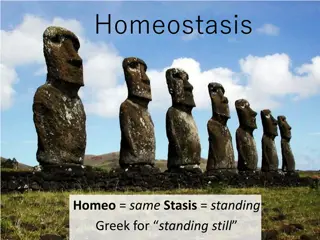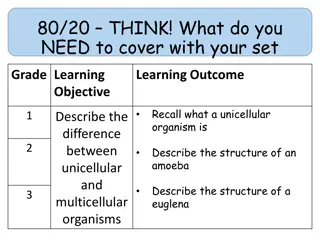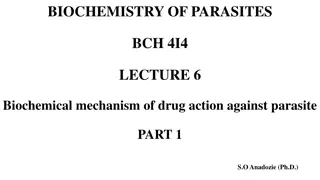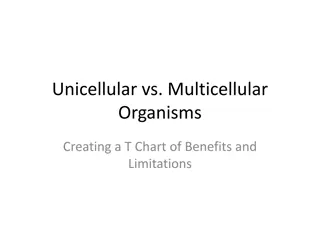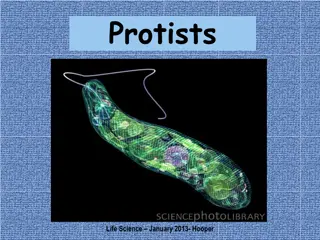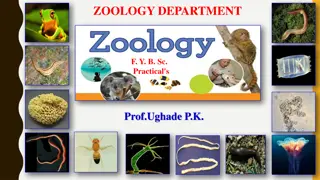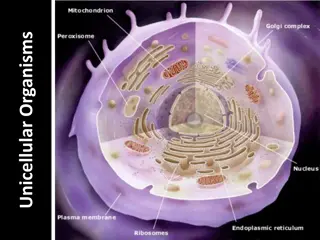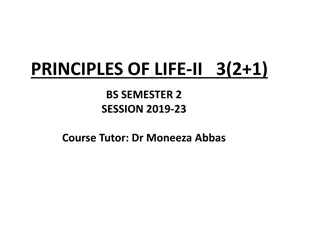Understanding Protozoa: The Animal-Like Unicellular Organisms
Protozoa are unicellular heterotrophic organisms that obtain nutrition by ingesting other organisms or dead organic material. They can be parasitic and are classified based on their modes of locomotion. Common groups include amoebas, flagellates, sporozoans, and ciliates. Protozoa are further categorized into different phyla based on their characteristics and taxonomy. Amoebas, for example, use pseudopods to move and engulf food, while Paramecium move using cilia covering their bodies. Understanding the characteristics and behaviors of protozoa is essential in studying their diverse ecological roles and impact on various environments.
Download Presentation

Please find below an Image/Link to download the presentation.
The content on the website is provided AS IS for your information and personal use only. It may not be sold, licensed, or shared on other websites without obtaining consent from the author. Download presentation by click this link. If you encounter any issues during the download, it is possible that the publisher has removed the file from their server.
E N D
Presentation Transcript
Animal Like-Protista (Protozoa) All are unicellular heterotrophs. Nutrition by ingesting other organisms or dead organic material. Some organisms are parasitic, since they cannot actively capture food. They must live in an area of the host organism that has a constant food supply, such as the intestines or bloodstream of an animal.
Animal Like-Protista (Protozoa) The protozoans are grouped on the basis of their modes of locomotion to: Pseudopods move by psedupodia such as Amoeba Flagellates move by flagella such as Giardia Sporozoans do not move such as Plasmodium Ciliates move by cilia such as Paramecium
Protozoan Taxonomy: Phylum Sarcomastigophora Subphylum Mastigophora Subphylum Sarcodina Phylum Apicomplexa Phylum Ciliophora
Sarcodina (Pseudopods) e.g Amoeba Have no wall outside of their cell membrane. Use extensions of their cell membrane (called pseudopodia) to move, as well as, to engulf food.
Sarcodina (Pseudopods) e.g Amoeba Amoebas live in water, dissolved nutrients from the environment can diffuse directly through their cell membranes. Most amoebas live in marineenvironments, although some freshwater species exist. Freshwater amoebas use contractile vacuoles to pump excess water out of the cell.
Most amoebas reproduce asexually by fission Amoebas may form cysts when environmental conditions become unfavorable. Two forms of amoebas have shells, made of calcium carbonate or silica.
Feeding: When the pseudopodium traps a bit of food, the cell membrane closes around the meal, this forms a food vacuole. Digestive enzymes are secreted into the food vacuole, which break down the food. The cell then absorbs the nutrients.
Paramecium [Credit: John J. Lee] Ciliophora (Ciliated Protozoa) e.g Paramecium Move by the cilia covering their bodies. They can be found almost anywhere, in freshwater or marine environments. Probably the best-known ciliate is the organism Paramecium.
Ciliophora (Ciliated Protozoa) e.g Paramecium Paramecia have many well-developed organelles. Paramecia have two nuclei, a macronucleus and a micronucleus. The larger macronucleus controls most of the metabolic functions of the cell. The smaller micronucleus controls much of the pathways involved in sexual reproduction.
Ciliophora (Ciliated Protozoa) e.g Paramecium Thousands of cilia appear through the pellicle, a tough, protective covering surrounding the cell membrane.
Feeding: Food enters the cell through the oral groove (lined with cilia, to "sweep" the food into the cell), where it moves to the gullet, which packages the meal into a food vacuole. Enzymes released into the food vacuole break down the food, and the nutrients are absorbed into the cell. Wastes are removed from the cell through an anal pore. Contractile vacuoles pump out excess water, since paramecia live in freshwater surroundings.
Reproduction: Paramecia usually reproduce asexually, by transverse fission When conditions are unfavorable, however, the organism can reproduce sexually. This form of sexual reproduction is called conjugation. During conjugation, two paramecia join at the oral groove, where they exchange genetic material. They then separate and divide asexually
Apicomplexa (Sporozoans Protozoa) e.g Plasmodium Sporozoans are all parasites e.g Plasmodium Many of these organisms produce spores, reproductive cells that can give rise to a new organism. Sporozoans typically have complex life cycles, as they usually live in more than one host in their lifetimes.


